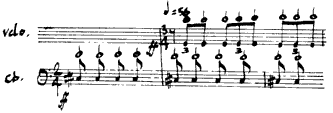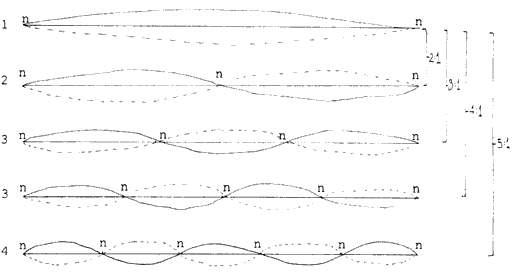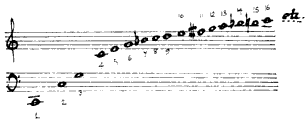rhoadley.net music research software blogs
aru seminars m&t critski focm1a cmc circuit bending mic2b sensor technology comp 3 sonic art major project
youtube vimeo facebook
Composing and Improvising
AF115003S
Instrumentation
piano
strings
woodwind
brass
percussion
guitar
harp
part-writing and transposition
Strings
For good examples of string writing listen to the following pieces:
- Vivaldi The Four Seasons
- Bach Double Violin Concerto in D minor
- Bach Solo Violin Sonatas and Solo 'Cello Sonatas
- Beethoven Strings Quartets (especially the late ones)
- Bartok String Quartets (especially no.s 4,5 & 6
- Penderecki Threnody for the Victims of Hiroshima
- Ligeti String Quartet 2
Tuning

Image

Fingering

Divided Strings
It: divisi; Fr: divises; Ger: geteilt.
Negation:- It: unis(oni); Fr: unis; Ger: nicht geteilt.
If double stops are required use Non Divisi, otherwise: div in 3; div in 4, etc.
If only half the section is to play mark the part half; It: la meta; Fr: las moitie; Ger: die halfte.
Negation:- all; It: tutti; Fr: tous; Ger: alle.
Bowing
Legato
 (Franck)
(Franck)
If no slurs are marked, each note is played with separate bows.
Slurs: Where slurs are marked, all notes under one slur are played in one bow, (that is, with no change of bow direction).

The up-bow (v) is usually associated with the upbeat in classical and romantic music.
The down-bow is usually associated with the downbeat.
For vigorous attacks on a long note, begin with a down-bow and follow through with an up-bow:

Also note that, due to the movement and position of the bow, the up-bow lends itself to crescendo, the down-bow to diminuendo.
Up-beats will sound louder because the two notes must be played with the same length of bow as the four notes of the down-bow. If this is a problem, it can be solved as follows:

Non-legato
The bow changes direction with each note, but unlike legato playing, they are played so that the articulation of the bow changes can be heard. The effot is not as pronounced as is staccato, but is detached; the stroke is known by the French term detache. It is usually played in the middle or upper third of the bow, although sometimes at the point for lightness or at the heel for weight.
For vigorous emphasis and equality of stress, use a series of down-bows played near the heel.
Loure bowing
A combination of slurred and detached bowing which results in a semi-legato effect:
 (Sibelius)
(Sibelius)
Staccato
On the string: uses up and down movements of the wrist.
Off the string: spiccato uses spring and bouncing of the bow, also called saltando.
Also joute (thrown) bowing, also caled saltando (again!) or saltato, where the bow is dropped on the string and allowed to bounce. Groups of notes can be played together:
 (?)
(?)
Martellato (hammered): on the string. The bow does not leave the string and the stroke is very fast, with an abrupt start and stop. The note can be piano or
NB Bowings marked in printed scores are not always followed literally. Some markings are the work of an editor. Room for interpretation is usually assumed.
Effects
- Playing on the fingerboard; It: sul tasto, sulla tastiera; Fr: sur la touche; Ger: am Griffbrett.
This is not possible/difficult on the violin E string and the viola A string due to the shape of the instrument. The string vibrates more and produces a softer, floating quality.
- Playing very near or on the bridge: It: sul ponticello; Fr: au chevalet; Ger: am steg.
This produces a glassy and metallic sound, heavy in upper partials. To negate the above use modo ordinario, ord, or naturale.
- Col legno: with the wood of the bow - either struck (battuto) or dragged (tratto).
The latter produces very little noise. To negate use arco.
- Pizzicato
pluck the string (negation, arco).
The transition from arco to pizzicato takes an appreciable amount of time.
Pizzicato sound is more sustained in lower instruments than in violins. Rapidity of passages is limited by the speed at which the finger can pluck a string. Also, the larger the instrument (and the string), the longer the plucking takes.
Pizzicato can also be played with the left hand. The notes are arranged so "that a finger is free to pluck a string, or when a finger is so placed that it can pluck as it is raised after stopping a note." Left-hand pizzicato is indicated by a cross over or under the notes. It should be used sparingly!
 (Stravinsky)
(Stravinsky)Chords of three or four notes in pizzicato are arpeggiated from the bottom up, unless otherwise marked. A series of quickly repeated chords is more effectively played by alternating back and forth using one or more fingers.
 (Prokofiev)
(Prokofiev)Two notes can be played simultaneously, in which case use a bracket and/or non arpegg..
Bartok or slap pizzicato - the string is plucked hard so that it snaps against the fingerboard. This is shown by the following signs:
 (Ligeti)
(Ligeti)
- Harmonics

This translates as follows:

The following is the harmonic series:

All these harmonics and more are present in any note produced on an acoustic musical instrument. The number and comparative strength of these gives the instrument its individual tone colour or timbre. The fundamental is usually much stronger, although the lower harmonics can usually be heard quite distinctly.
If a vibrating string is touched very lightly at one of the dividing nodes shown above, the fundatmental is prevented from sounding, but the appropriate harmonic will sound. So:
Touch the node half way along (see above, 2) and the 2nd harmonic (an octave) will sound.
Touch the node either one or two thirds along the string (see above, 3), and the 3rd harmonic (an octave and a half above the fundamental) will sound. These are harmonics, and sound very different from normal tones because only the tone indicated sounds, with no other harmonics. These are notated:

- Artificial Harmonics
On violin, viola and 'cello it is possible to stop a string with the 1st finger, and at the same time touch a node with the fourth finger (or third on the 'cello). This creates an artificial harmonic.
The most dependable and popular of these is that of the fourth harmonic, the node being at a point that is a quarter of the string's new length. In notation this node is represented at a point a perfect fourth above the stopped tone, and the resulting tone sounds two octave above this. It is notated:

- Tremolo
Fingered Tremolo
For true (that is, as fast as possible) tremolo add the words tremolo or tremolando (abbrev.: trem. above. Slurs are necessary to show bow movements:

- Bowed Tremolo
1) When the interval of the trem. exceeds the extension of the fingers on one string, the two notes are held by a double-stop, and the tremolo effect has to be made by an undulating motion of the bow, alternately touching the two strings. The effect produced is not as clear as in fingered tremolo, it is also more difficult to achieve a very fast trem:

2) Very fast up and down movement of the bow:

Use trem to ensure sufficient speed.
- Mutes
It: con sordini, con sord.; Fr: avec sourdines; Ger: mit Dampfer, gedampft.
Negation: It: senza sordini; Fr: sans sourdines; Ger: ohne Dampfer.
The effect is one of reducing the amplitude of vibration - especially in the high frequency. Amongst a body of strings this causes quite an alteration in tone colour.
Time must be provided to take on and put on mutes.
- Scordatura
The altering of standard tuning is rare, but where used, usually to extend one or more strings by a semitone, for example moving the 'cello C string down to B. The problems of retuning the instrument during performance are often great enough to nullify any gain.
- Double-stopping and Chords
Whereas two notes can always be played together, because of the shape of the bridge, three cannot be simultaneously, except when the chord is loud and short, with enough pressure to depress the central string.
In other three and four note chords, either the top note or two top notes are held after playing the lower notes as grace-notes, usually before the beat.
It is best to determine the practicability of any multiple stopping by understanding the location of the fingers on the fingerboard of any stringed instrument.
Thus:
 is easy to play, whereas
is easy to play, whereas is very difficult.
is very difficult.Fifths are hard to play in tune:
 .
.Open strings are especially useful:
 .
.The unison of stopped tone and open strings is very resonant:
 .
.Chords may also be broken, as long as they work well as chords:
 .
.In this case the bow may be used to play legato, or bounced as described above.